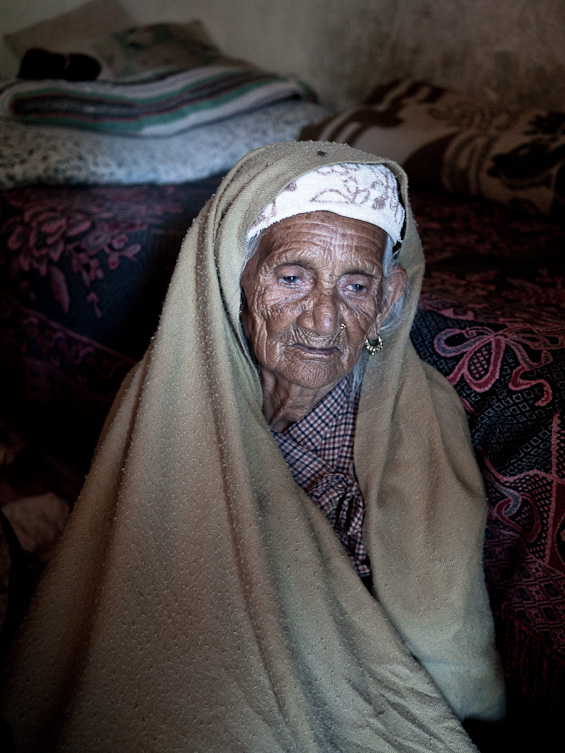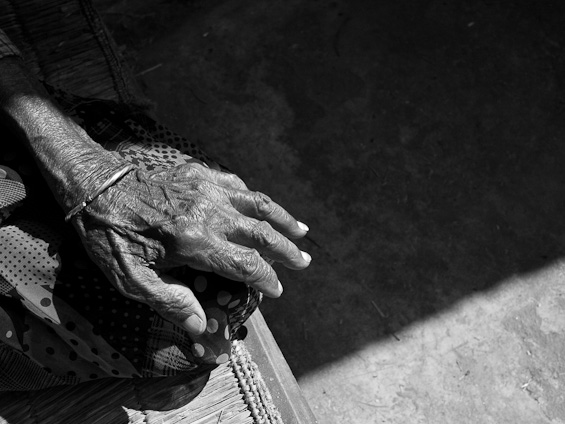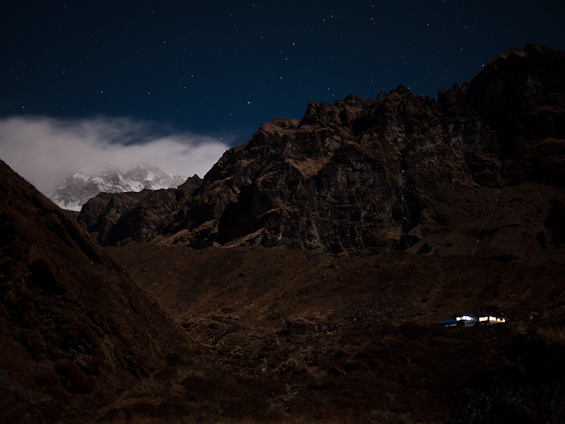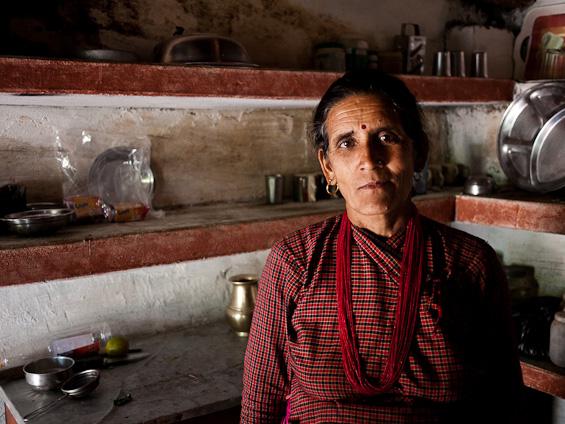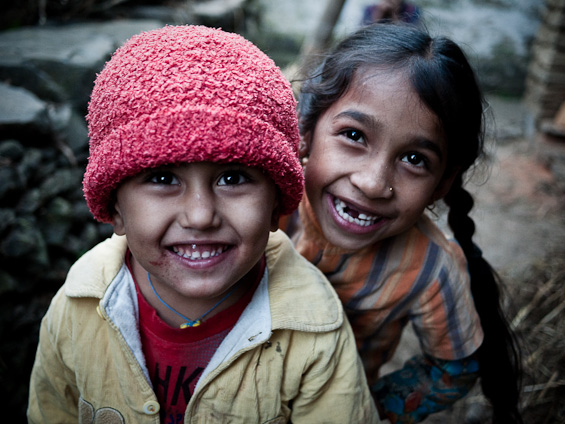The GF1 is a near perfect travel camera.
For 16 days I lived with it strapped to me as I climbed through the valleys of central Nepal up to Annapurna Base Camp at 4,200 meters.
I covered the camera in sweat. I hit it against rocks (unintentionally). The air was often dusty and this dust, by the end of the trip, had worked its way into every nook of the GF1. And yet it performed flawlessly. Never once did it stutter or complain or fail to take an image when I asked it to. And only rarely did it take the wrong image.
The compact combination of Panasonic's GF1 body and the 20mm f1.7 Lumix pancake lens works with you as a traveler. It's a light, sturdy, capable, exceptionally well conceived photography kit that demands to be taken on adventures.
Update: A supplementary video gallery is now online.
A farm Near Pokhara
Her story is simple: she’s a 90 years old farm girl. In a country with an average life span of 65 she is a miracle. It would be like walking in on a 111 year old woman in Tennessee. A 111 year old woman who has spent most of her waking life in rice paddies.
She is the oldest person in the village (of about 15,000). And despite the protests of her family, she constantly tries to help out — sweeping around the endless dust or preparing food. Declaring that if she stops moving she’ll die.
Her hands are as weather worn as her face (but soft) and I held one of hers with my left, as I photographed with my right.
The small size of the GF1 and lack of viewfinder allowed me to be somewhat discreet — shooting from the hip. We chatted, as interpreted through Hom, her grandson, and I snapped away.
What I love about this camera
Size — There’s very few cameras in the world that take this high a quality of photograph that I’d be willing to hang around my neck all day long. Everyday. For weeks. Furthermore, there’s few cameras of this caliber that easily fit in your day-pack. Or that add only a trivial amount of weight to your outfit. As any trekker knows, every ounce is writ a hundred fold large when you’re climbing 1000s of feet a day. By the second day my neck was loving me for carrying the GF1 instead of my standard Nikon kit.
Design — The styling is understated and simple. It’s the sort of camera that catches the attention of aficionados but goes almost totally unnoticed by average folk. Those that do notice, strangely tend to think it must be a film camera, which I consider a compliment on the design.
Interface — Panasonic has done a helluva job achieving two critical interface points: they’ve managed to give you access to hundreds of features with minimal fuss and they let you ignore the hundreds of features unless you really need them. The buttons feel solid and well made. By the end of my trip shooting in aperture priority and manipulating the settings to my liking had become effortless.
Time and time again I was able to see a shot while hiking up valleys edge, grab my camera from around my shoulder, pull it up, turn it on, compensate for light changes via f-stop, get the shot and turn it off all within a couple seconds. Of course, most good pro-cameras let you do this. The difference is the GF1 stays out of your way entirely between shots. It doesn't feel like an unwieldy anvil around your neck.
Construction — The camera has a well considered, solid heft. The body feels capable of absorbing a reasonable amount of abuse. What I can report with unwavering certainty: I smacked the hell out of my GF1 in the mountains and it still looks and functions like new.
HD Video — The biggest surprise for me was how much fun it is to shoot video on the GF1. There's a dedicated video button next to the shutter release so activating video mode is trivial and inviting. Chose a target, get the focus right, set the camera down and let it go. Pairing HD video with the shallow depth of field of the 20mm f1.7 lens makes for mindlessly sexy, film-like output. Sadly the GF1 doesn't accept an external microphone (and only captures audio in mono), but for short vignettes of life along the road, it's perfect.

1/3200 sec, f/1.7, ISO 100 1:1 Zoom
Climbing out of Phedi
This was the first photograph I took of him. It was just minutes after we began our ascent of the steep, well worn steps from Phedi. Already covered in sweat, wondering what the hell I was getting into, I looked up and saw him in the early morning light.
I can see something now I couldn’t see then: His posture is bent. He’s leaning into his step. There’s a weight on his shoulders you don’t see in later photographs.
On the final day I find out he recently lost his younger brother. Some sort of accident. He tells me he was sad when the trek started but walking together somehow changed him. It’s a lovely and apt metaphor — his spirits rising as we scaled the central Nepalese valley together.
I took dozens of photos like this — images suddenly appearing in the middle of a climb. Despite carrying a thirty pound pack and engaging in a continuous, massive cardiovascular undertaking, I was able to seamlessly capture them. The camera always around my neck and ready.
GF1 Aperture priority: One Handed Photography
Shooting in aperture priority with the GF1 is effortless. 99% of all control you need sits in three easily accessible buttons (see image).
By default the thumb dial (top-right) allows you to cycle through f-stops. Whereas with an aperture ring on a traditional lens you can shift from the lowest to highest f-stop in one precise, swift movement, shifting from f1.7 to f16 with the thumb wheel is much more tedious. But I find most of my aperture manipulation is within small ranges to compensate for available light or to control depth of field. So this was rarely an annoyance.
Pushing in on the thumb dial switches to exposure compensation. It's here you can have the GF1 under- or overexpose a few stops away from what it determines 'proper exposure.' This is especially useful in certain bright outdoor conditions where the camera tends to consistently blow out details.
Conveniently located to the left of the thumb dial is the auto-exposure / auto-focus lock. The GF1 usually does a great job hitting the exposure or focus on its own. I rarely ever used this function. But it was nice to have it where one would expect it to be when needed.
Ages ago when I shot film, I often shot Fuji Velvia, an ISO 50 slide film. Anyone who has experience with it know's it's an utter bitch to use. But because it produces some of the most beautiful, smooth colors and gradients known to 35mm film, the cult following for it was vast. When I was twenty years old I hitchhiked from Tokyo to Fukuoka over the course of a month and shot Velvia and Velvia only, like the masochistic rookie I was.
Thanks to the quickness of the 20mm f1.7 lens, you can leave the GF1 at ISO 100 most of the time. Only when I entered a particularly dark interior space, or was trying to speed up a night shot did I ever ratchet it up.
Changing ISO is straightforward, and those less anal than myself can have the camera do so automatically. You can even set a maximum ISO to stay within. Still, the ISO button sits pleadingly at the top of the directional panel on the back of the GF1, just asking to be used. And so use it I do.
Because of the diminutive size of the GF1 and the thoughtfulness of the control layout, it's wholly possible to operate it one handed with little fuss.
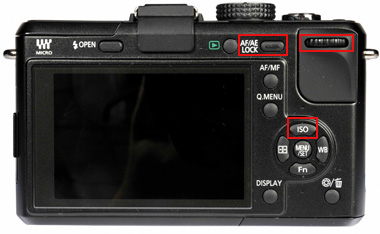
Whether shooting an old woman in a dark, dusty room or taking minute long exposures in full moon light, these three buttons are almost all I ever touched.
Midnight at Basecamp
I wondered why I was carrying a tripod with me. At first, I assumed I’d use it for video — just plop the camera down in the middle of a busy intersection and shoot exotic life passing by. But then we arrived at Chomrong and the mountains revealed themselves to me at night.
It was then, standing out in the freezing cold, looking at the first long-exposure night shot of the surrounding peaks that I realized why I was hauling along the tripod.
The moon grew fuller the higher I climbed. The evening skies were always clear. And by the time I reached Macchapucchre and Annapurna Base Camps, it was completely full and very bright.
Even with the moon, the lack of light threw off the autofocus. The GF1 would place the focal point just before the infinity mark, pushing the mountains into a slight blur. Manually focusing to a focal extremity on this lens is trickier than you might think — since there is effectively no ‘beginning’ or ‘end’ to the focus ring (it simply turns and turns and turns) it takes some practice to find true infinity.
The GF1 handled the night shots with a lot of grace. Despite windy conditions and a light-weight tripod I was surprised by how sharp the final images were.
Also, I was pleasantly surprised to find the long exposures weren't as much a drain on the battery as I assumed they would be. I spent hours in the freezing cold (with a hot thermos stuffed in my shirt) exposing and waiting and confirming, over and over again. All without denting the battery indicator.
The one let down was that no matter how hard I tried, I couldn't seem to capture detail in the moon. It was simply too bright.
Why I PHOTOGRAPH
I photograph to be able to reflect back on and process experiences.
Video feels too immutable. The narrative too well defined. The ambiguity of a photograph is why it's such an effective tool (for me).
Memory of travel is fleeting at best. Those highly corporeal experiences — the nostril burning stink of cows on a farm, the crispness of morning mountain air on your face, the full body ache of an all day climb — quickly fade. I find it can take me months or even years to process a trip, to really understand its meaning. Photos serve as road-markers for returning to those experiences. They keep them real, if somewhat framed. And going back allows me to both experience them again as a different person, and simultaneously recall who I was when I took the photos.
These are my photography rules
- RAW only. JPEG quality is irrelevant because it seems insane to shoot anything but RAW. I’m shooting for documentary and archival purposes, as I think we all should.
- Mainly aperture priority.
- Mostly Auto Focus because things move quickly in real life.
- Everything handheld. Night shots with a tripod.
- No flash. Almost always available light.
- Edit. Edit. Edit. And post-process. I spend tons of time in Lightroom editing and filtering images — trying to find thematic threads — and performing 'standard' darkroom post-processing.
Memory of travel is fleeting at best. Photographs serve as road-markers for returning to those experiences.
Human Scale
About halfway through the trip I realized something strange was happening — the people I photographed were looking me in the eyes. Indeed, they could see my eyes! I had spent so long traveling with a DSLR strapped to my face that I had forgotten about true eye contact.
For better or worse, a camera without a viewfinder is less intimidating. You are no longer half-human half-camera. You're all human with a tiny play thing in your hand. The GF1 is so compact I don't think people take it seriously. Which is wonderful if you want candid, real photographs. Subjects focus on being human rather than being a subject.
I had just finished lunch when I took this first photo. She was an intense but kind woman. I don't think I ate enough — usually one takes several helpings of rice and lentils but I was stuffed and so had only one plate. She was scolding me ("Eat more!") when I realized what a beautiful backdrop the room made for her.
The children in the second photo ran up to me just as I was staring into the eyes of a water buffalo. The little girl was pushing the child with the hat into me, laughing. I don't think they'd seen someone staring so deeply into a buffalo's eyes before. Giggling and jostling and yelping, the GF1 did a pretty good job keeping them in focus despite the dim morning light.
What I don't love about this camera
There are very few things I don’t like about the GF1, but here they are:
Over Exposure — I found that I needed to underexpose my mountain / nature shots by a stop or two to keep the GF1 from blowing out detail. This was particularly evident in snow-capped mountain tops and it took me a few days to recognize this flaw because …
The LCD — The LCD is big and sexy but almost totally worthless in broad daylight. This is an issue for any camera lacking a viewfinder. That said, the GF1 does a great job exposing (most things), hitting focus targets and generally getting you the image you want. As I suggest above — simply underexpose a stop or two for outdoor, direct light shots and you should be fine. Anyway, you’re shooting RAW right? We can fix our color and white balance issues in Lightroom.
The lack of a great EVF — I tried the Electronic View Finder (EVF) Panasonic sells as an accessory for the GF1, but it felt cramped and of too low a resolution. I know they can do better — the clarity of the EVF for Panasonic's pro-level GH1 reminded me of the first time I looked into the ground glass of a Hasselblad — like peering into another world. A GH1 level EVF would come in handy for bright, daytime shooting and also for discreet night shooting.
Autofocus in movie mode — Because of the nature of the algorithm for contrast-detect auto-focus, the camera can't intuit which direction to shift the focus without first moving in both directions. This is totally a non-issue for photographs, but painfully distracting in movie mode. The solution? Get good at focusing video manually.
See video samples here.
High ISO Noise — Have you ever seen what a pro-level Nikon can do at ISO 3200? Or even better ISO 64,000? Well, pretend you haven't and you'll enjoy using the GF1 a whole lot more.
The GF1 is pitch perfect at ISO 100. At 200 we're still OK. At 400 the ship begins to wobble. And 800 should only be used in dire situations. Would it be nice if the GF1 could take flawless images at ISO 3200? Of course. But thankfully, the speediness of the 20mm lens usually allows you to get away with all but the most difficult shots with ISO 800 or lower.

1/800 sec, f/8, ISO 400 1:1 Zoom

1/800 sec, f/9, ISO 400 1:1 Zoom
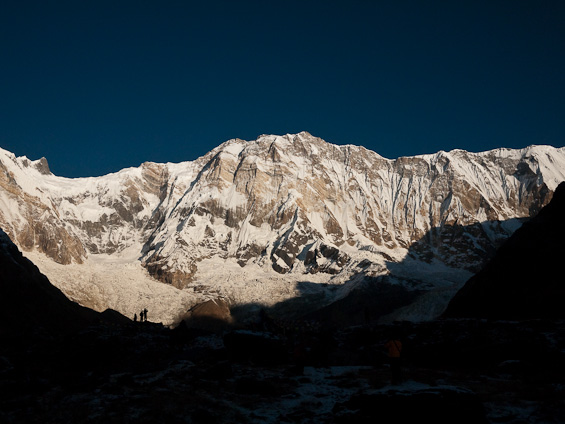
1/3200 sec, f/7.1, ISO 400 1:1 Zoom
Waiting, light, contours
Some of my favorite shots from the trip were interior shots struck by perfect light. There were times where I’d go back to a room half a dozen times until the light was finally there. Outdoors, I’d spend hours sitting on rock ledges reading a book with one eye and watching for changes in light over the landscape with the other.
It’s these meditative moments of anticipation I remember most vividly when I think back on a place. In waiting you become intimate with your field of view. I almost always carry a notebook and find that performing blind contour drawings — drawing the contours of objects without looking at the paper — can help connect you with a landscape or subject like nothing else. It forces you to focus intently on the subtleties and shifts in the edge of a mountain, a person's silhouette, the curve of a tree branch or the irregularities in a rooftop. Then, when the light is finally there, you begin to photograph. And because you’ve been engaged in silent dialog with the landscape, you know how to photograph it.
These three shots all involved waiting. And waking up early.
The first two were taken in a small village I spent a night on my descent. I woke up painfully early, had a omelet and pot of delicious coffee and set out just as the sun was starting to creep over the opposing side of the valley. I didn’t want to miss seeing firsthand how the the village was affected by shifting shadows and quality of morning light.
The third image was taken during sunrise at Annapurna Base Camp. This is an photo of Annapurna, the first 8,000 meter peak ever summited by a human (French climber Maurice Herzog in 1950). I was out on the lip of a tremendous moraine for about an hour before the morning sunlight marched down far enough to capture the silhouette of those fellow trekkers.
A capable, beautiful, compact machine
In summary, the GF1:
- is tough enough to bang around on a wilderness adventure
- adds very little weight to a trekker's pack
- can handle almost any situation when parred with the beautiful 20mm f1.7 lens
- functions fine covered in midday sweat or at -10°C at 4200 meters
- is capable of fairly low-noise long-exposure night shots
- doesn't intimidate subjects
- produces beautiful RAW data
- has a great battery life
- outputs impressive HD video
- is small enough to get the hell out of the way when not in use
- is a whole lot of fun to use
It should come as no surprise that I am in love with this little camera. Something about it has gotten me to take more photos in the last three months than I have in the last two years combined. In fact, this camera was one of the impetuses that led me to Nepal — I wanted a great subject on which to use it.
A GF1 outfitted with the 20mm lens represents the following: a compact, beautiful little machine capable of producing archival quality photographic RAW data. It’s always with me. Almost never a burden. And every time I dump a day’s worth of shooting into Lightroom, I feel like that little kid so long ago, rediscovering why I became infatuated with photography in the first place.
The GF1 seems to demand one thing: throw it around your shoulder and find a worthy trip.
Highly Recommended
About the images
All images © Craig Mod 2009.
Image reproduction is available under the Creative Commons Attribution-Noncommercial-Share Alike license. If you wish to use these photos in a commercial context, please contact me directly.

This work is licensed under a Creative Commons Attribution-Noncommercial-Share Alike 3.0 United States License.
All images taken with the Panasonic GF1 + Lumix 20mm f1.7 pancake lens. All post-processing done in Adobe Photoshop Lightroom 2.
Disclaimer:
None of this has been subsidized or sponsored. All opinions are my own. Influenced only by altitude sickness and too much dal bhat.

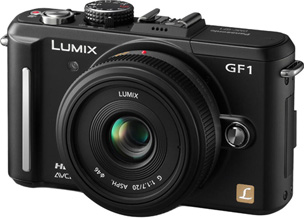
 Panasonic Lumix DMC-GF1 with 20mm f/1.7 Lens
Panasonic Lumix DMC-GF1 with 20mm f/1.7 Lens Panasonic Lumix G 20mm f/1.7 Aspherical Pancake Lens
Panasonic Lumix G 20mm f/1.7 Aspherical Pancake Lens